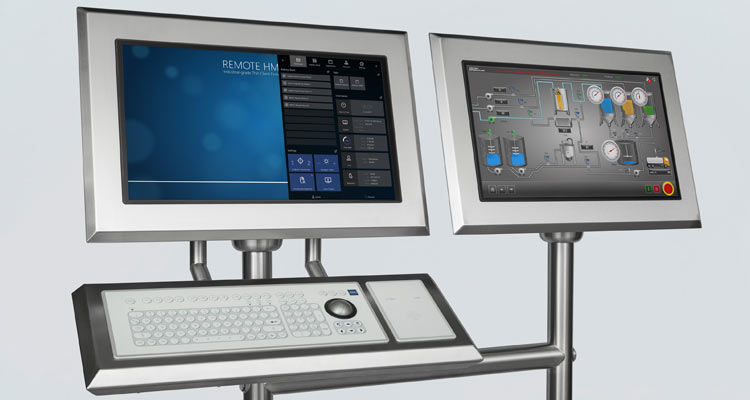Optimum access to information: with dual monitors in the field at DCS, MES and ERP
In chemical and pharmaceutical production plants, HMIs are required to provide as much data as possible for a solid basis for decision-making and to ensure the safety of the production processes. Increasing digitalisation and interconnected technology in the production processes generate a great variety of data for the operating and control stations, such as plant status, process values, maintenance intervals and ERP-relevant data. For the optimum management of this data volume, an ever increasing number of companies in the process industry are using dual monitors in hazardous areas to provide separate access to the PCS and ERP, for example.
Dual monitor management in the field
Large production plants such as world-scale, multi-purpose and integrated facilities provide a large amount of process information on site that may, depending on their status, be relevant to the process. Field operating devices in industrial facilities are thus increasingly turning into mini "on-site control stations", and the local operators carry an increasing amount of responsibility: they are turning into "on-site process managers".
It is practically impossible to display such a large volume of diverse data on one screen, especially to aid decisions based on information from two systems, such as the PCS and the MES. For informed decision-making, dual monitor solutionss can be used to access and view both data sources in parallel. One monitor can be used to visualise the PCS, and the other to display maintenance plans for the field devices, production resource management, project control or documentation. Machine data, maintenance, logistics and QM information can also be integrated. Process operators are thus informed promptly of any changes and anomalies and can then initiate appropriate safety measures.
Professional authorisation management and RFID authentication
The larger volume of information provided to the dual monitors and the increased level of on-site responsibility require the authorisation management to be clearly defined. Who can access what? Who has to authenticate themselves where and how? All this is part of a professional authorisation management. Incorrect access and insufficient user authorisation management can have dangerous consequences for the production process.
Users often have to change field stations. The security-relevant log-on and log-off processes often prove to be cumbersome and time-consuming in practice. Entering user name and code - often with gloved fingers - as well as easily verifyable passwords make log-on processes not only time-consuming, but also system-relevant. This is why we recommend explosion-protected HMIs with proximity RFID readers for authentication, which greatly reduce the time required for authorised access to process control. How? By placing the workplace ID card onto the reader, which then remains in place throughout the time of access. The users are identified as authorised via their RFID ID card, and authenticated vis-a-vis the company's active directory. A LogOnPlus software is used to log the user via an application-specific connector onto the target application, with the data stored in the system. A further USB interface can be used to connect barcode readers for professional material identification and logging.
State-of-the-art dual monitor solution thanks to firmware
The easy integration of RFID readers is part of a modern, industrial-grade Remote HMI firmware, and an integral part of Thin Clients. The firmware ensures safe, manipulation-proof remote access to virtual or real work stations within a network as a closed system with a uniform operating concept. All major protocols such as VNC and RDP are supported. The app concept allows for CITRIX access, protocols such as Delta V Remote Desktop Connection (DRDC), browsers, CCTV apps or any other applications to be operated securely and without modification of the Remote HMI firmware. The firmware provides a customised authorisation managementwith graded access rights for authorised access to centrally stored or cloud-based programs and applications.

Further Reading:
These articles might also interest you

Use case: Provision of all documents and certificates





![[Translate to Englisch:] [Translate to Englisch:]](/fileadmin/user_upload/mitarbeiter/01_DE/07_Blog/00_Allgemein/blog-explosionsschutz-rstahl-startseite-279x205.jpg)
![[Translate to Englisch:] [Translate to Englisch:]](/fileadmin/user_upload/mitarbeiter/01_DE/07_Blog/00_Allgemein/blog-explosionsschutz-rstahl-ueber-den-blog-279x205.jpg)
![[Translate to Englisch:] [Translate to Englisch:]](/fileadmin/user_upload/mitarbeiter/01_DE/07_Blog/00_Allgemein/blog-explosionsschutz-rstahl-autoren-279x205.jpg)
![[Translate to Englisch:] [Translate to Englisch:]](/fileadmin/user_upload/mitarbeiter/01_DE/07_Blog/00_Allgemein/blog-explosionsschutz-rstahl-newsletter-expert-mail-279x205.jpg)
Write new comment